

 The Accurate Reloading Forums
The Accurate Reloading Forums  THE ACCURATE RELOADING.COM FORUMS
THE ACCURATE RELOADING.COM FORUMS  Hunting
Hunting  European Big Game Hunting
European Big Game Hunting  capercaillie
capercaillieGo  | New  | Find  | Notify  | Tools  | Reply  |  |
| one of us |
There wasn't much info found in an archive search. I was wondering who has done this hunt and what your thoughts were about it. The spring stalking hunt during the mating season sounds very interesting. That part about them closing their eyes and not able to hear anything for a few seconds during their mating call is fascinating. It almost sounds like a joke but they say it's true. I tried to find a online recording of their unusual mating call but haven't found one yet. I understand that part of it sounds like champagne corks popping. Any photos? It sounds like a great hunt to use a drilling on. Who are some of the operators to consider for a hunt like this? It sounds like some hunts are with dogs, some are on foot, some are on skis. _______________________________  | ||
|
| One of Us |
Hi! I do hunt these birds, but as with all hunting here it is strictly illegal to hunt during the mating season! All species are protected during the mating/rut. (for moose there is a period during the season where it is illegal to hunt them due to the rut where they get nasty to eat & do not care at all about hunters, dogs and respond so easily to calling) The reasons are that it is too easy since they are occupied with mating, and that the meat is not of so good quality with all the hormones in it. It was a popular hunt around 1850-1930 though, before biological concerns started to get attention and we had regular hunting seasons. Here hunting season starts 25 august & stops 31 january for the males, females are protected from mid november I think. They are both blind and deaf during some parts of their play and you can get very close if you know when to move and when to stand still. Both sexes are so full of hormones that they do not hesitate to try to attack a car, ATV, logging machine or pedestrian that happen to come too close. There are usually a few reports of horny capercallie attacks on humans every spring in the newspapers. They do "play" in the autumn as well, but shorter times and they are more vigilant and harder to get close to. I doubt that it would be legal anywhere within the EU to hunt during the mating season, since the EU-bird directive explicitly prohibits all such activities, regardless of if both sexes participate in the care of the hatchlings or not. I hunt these with my 12 ga sbs in the autumn, the .22 hornet & sbs in late autumn, .22 hornet or 6,5x55SE in winter. Depending on snow conditions it is either foot, snow shoes or going on skis that does the trick. In wintertime, 200 m is a average distance to shoot at, very seldom you get closer than that before they take off. In some other parts where there is more of these birds You might get lucky to get one much closer. I have hunted these during the winter for 15 years and still not found one male in the top of a pine tree. I do see them frequently during the autumn though, but there are better places further south to get those big birds with a rifle or drilling. Sincerely Daniel | |||
|
| one of us |
Thanks for the reply. I wasn't aware of the legalities as most of the info I had read was old. It sounds like a really interesting hunt. _______________________________  | |||
|
| one of us |
No, no, Daniel cited regs from his home country (Sweden, I presume?), but the regs vary from country to country. The traditional hunt in Central and Eastern Europe for Capercaille (and it's smaller cousin, the Black Grouse) is indeed a spring/rut hunt (do birds rut???). The traditional hunt is still possible in Austria and a whole bunch of Eastern European countries, such as Romania or Russia. The traditional hunt calls for you to locate the birds nesting tree in the evening - most commonly through droppings on the snow covered forest floor. You then have to get up waaay before dawn, and sneak up on the nesting tree. The birds do not always spend the night in the very same tree, so you may have to silently approach it. This is where the mating song comes in. As you mentioned, there are periods in this (repeated) song, during which the bird is both deaf and blind. So you await these moments, and as silently as possible try to move towards the bird. But as soon as the blind/deaf phase (In German: "Schleifen") is over (10-15 seconds, maybe?), you have to remain ABSOLUTELY motionless (regardless of what impossible position you happen to be in) until the next phase of Schleifen sets in. That can be a trying exercise, but the bird is rumoured to have an eye on every feather, so you have to give it your best shot, cramps or no cramps... (VERY exiting, if at times painful!) Eventually, you may have approached the nesting/singing tree sufficiently to have a clear shot, or the bird may have dropped to the forest floor and continued its mating dance (often in competition with other cocks, trying to impress the local girls...). Typically, the birds are shot with a small caliber rifle - the .22 Hornet is just about ideal, the .222 Rem is already on the heavy side. Shot is also possible, but you risk the bird spreading out its wings and riding off even after a solid hit with shot. In that case, there is no blood trail to put a dog on, and the birds are easily lost. Shot is commonly used in the East (e.g. Russia), though. Once successfully collected (photos shot, etc), the bird is given its "last bite" - a twig in the beak, and attached to the outside of the hunter's pack and brought home in triumph!! There are a few pictures of Capercaille (and related birds) in this PDF: http://www.mistral-jagd.at/angebote/2008/k18-19.pdf We have discussed hunting these birds in the past, see also: https://forums.accuratereloading.com/eve/forums/a/tpc/f/...=324107725#324107725 The birds are hunted differently in Scandinavia - typically in the fall or winter. Often on skis and/or with dogs. Here hunters seem to use larger calibers (6.5x55, .308 etc) with FMJ bullets. - mike P.S. one of the better places to hunt Capercaille as a non-European is Russia. They have the biggest populations by far, and the hunt is not particularly expensive. One often flies to Moscow, and then takes an over-night train to the hunting area. Typically, the hunt is combined with Black Grouse. A Drilling would not be bad choice, though preferably it should have a small caliber rifle barrel - a Hornet or a .222, say. ********************* The rifle is a noble weapon... It entices its bearer into primeval forests, into mountains and deserts untenanted by man. - Horace Kephart | |||
|
| one of us |
Thanks for the informative reply. I had seen the other topic where you posted some info but that is about all I could find on AR besides some misc. comments. It's good to hear that the spring hunts are still available as that is much better timing for me and it sounds like the most interesting hunt...stalking between bird calls. I picked up an older book yesterday called "Great True Hunts" published in 1967. The last story in it is called "Europe's Toughest Trophy" and it is a story about a hunt for auerhahn in Austria. It's an interesting hunt that you don't hear much about. The Russian hunts sound the most interesting to me thus far. Are there any Russian operators in particular that are recommended? Also, I tried to translate the website using Babelfish but it didn't work. That's a German website, correct? _______________________________  | |||
|
| one of us |
Yukon, It is no big sweat to book a hunt for capercaille (and likely other birds) in Russia. The way I would go about it, is to use a reputable European hunting consultant. They have arranged these hunts for decades, and have a good idea of where to go. Try: http://www.profihunt.com/en/pr_caper_kirov.html (This guy is directly in Rusia). http://www.mistral-jagd.at/ (This was the the consultant whose PDF I linked above - at least allows you to see prices. Send him an e-mail in English). http://www.westfalia-jagdreisen.de/ (Follow link Jagdlaender -> Europ. Rusland and you get to page: http://www.westfalia-jagdreisen.de/jagdlaender/europa/e...hn/auer-birkhahn.htm. On this page there is a link at the bottom for prices etc. Send mail in English). - mike ********************* The rifle is a noble weapon... It entices its bearer into primeval forests, into mountains and deserts untenanted by man. - Horace Kephart | |||
|
| one of us |
Thanks Mike for the assistance and the links to more info. _______________________________  | |||
|
| One of Us |
Sorry, I`m too stupid too post. If I could send someone a picture, Perhaps you could post? I know how to send via E-mail. Drop me a pm if anyone wants to see. | |||
|
| one of us |
I can do it for you. PM sent. _______________________________  | |||
|
| One of Us |
Gents! As long as you are in a non-eu country there could be more possibilities of different hunts. What I do know is that the european bird directive acts all over the union and prohibits hunting throughout the community unless it is stated as a exception in a countrys membership status. The woodcock (Scolopax rusticola) was previously hunted in Sweden during the spring and it was a very popular form of hunting the flying males since they do not participate in the rearing of the eggs, it was legal until we joined EU. It is illegal now in Sweden due to the EU-bird directive, but legal in Hungary for some reason. Another thing is that Ravens are protected since 1973 because they are scarce in Greece, but there are as many ravens as crows here but we can still not hunt them and they do considerable damage to livestock and bird nests. So, basically it varies from country to country but within the EU you have to take the bird-directive into consideration. In the eastern part it would very well be possible for all kinds of hunts, and probably a lot of birds available as well, they might also have transit regulations as some are new members in EU. Basically it is all a big mess. You could also try to attract them by calling them with a wooden flute. In some countries that is legal, in others not. Here in northern sweden we hunt them mostly over standing dogs, Pointers, setters, vorsteh or or with barking dogs that make the birds sit in a tree until you can creep up close enough to shoot it down. I have heard from my grandparents generation that the birds they shot in the spring during ww2 for extra rations of food tasted very bitter compared to the ones shot in the autumn, so that might indicate that also birds do get in the rut. (I have no personal experience since it has been illegal to hunt them in the spring during all my life) We had a moose that was going into rut 1-2 days before we shot it, and it was not a pleasant thing to take care of, everything smelled musth and we had to clean it up much more than the other mooses before we could process it, but our butcher said it was "ok, with hesitation" to eat it. A picture of a lady that did not care at all about our car beeing 2 m from her, she owned the road and strutted along as she pleased.  Sincerely Daniel | |||
|
| one of us |
Daniel, I just checked the seasons for Capercaille and Black Grouse in Salzburg in Austria (where I hunted my Capercaille). The open season still includes May. So some EU countries are still hunting these birds during the mating season. Not sure what the underlying legal technicalities may be, so I'm not at all challenging your general statement about the EU, directives and what-not. That is way over my head, anyway. - mike ********************* The rifle is a noble weapon... It entices its bearer into primeval forests, into mountains and deserts untenanted by man. - Horace Kephart | |||
|
| one of us |
Posted for Asti. 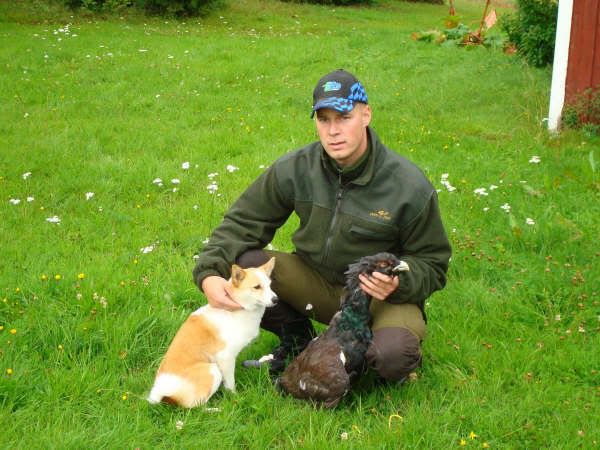 _______________________________  | |||
|
| One of Us |
Gents! As the bird directive acts all over the union, it is also possible for the different countries to negotiate exceptions for their country, and apparently the swedish politicians that negotiated those terms upon EU membership just bent over backwards to sign it. It does in principle cover the entire union, but each member state can negotiate exceptions depending on the stamina and courage of each negotiator. I do wish best of luck to anyone finding a hunt for these birds whenever it is legally possible for them in that part of the world, regardless of time of year. They are a magnificent prey to try to bag any time of the year. It seems like austria or russia are the places to go for a spring time hunt. Best of luck in getting one, I will have to wait until august before going after them again... Sincerely Daniel | |||
|
| one of us |
Hi Mike, You've probably told me this before but I can't remember. Is anyone hunting Capercaille and/or Black Grouse here in Switzerland? cheers, stu | |||
|
| One of Us |
Thanks yukon delta! The picture displays one of many succesful hunts with dog barking at the tree where the bird is situated. Just sneak up, without being spotted and finish the hunt. This is my absolute favourite type of hunt! The bird on the picture is only a youngster, probably a year old. | |||
|
one of us |
I went Capercaille hunting on the Kamchatka Peninsula a couple of years ago.  Happened upon this nice bear while hunting them.  Or maybe it was the other way around. Mike NEVER BOOK A HUNT WITH JEFF BLAIR AT BLAIR WORLDWIDE HUNTING! | |||
|
| one of us |
Stu, Capercaille is out of bounds in Switzerland, but some of the mountain cantons have a season for Black Grouse in the autumn (Glarus, for one). The birds are often shot with shot. - mike ********************* The rifle is a noble weapon... It entices its bearer into primeval forests, into mountains and deserts untenanted by man. - Horace Kephart | |||
|
| one of us |
Cheers Mike. I kicked-up a female Black Grouse last year while hiking in the mountains at about 1700m. Having something that size take off a couple of paces in front of you when you're not expecting it really gets your attention! | |||
|
| one of us |
I have been hunting cappercaillie for my first time this year, by the end of April. It was seven of us in the hunting party and we all found the hunt to ve very interesting. The approach to the bird is difficult and any untimely noice or disturbance will spook it and fly it away and you will have to call it a day when it is only 5 in them morning. In all it is in my opinion a very exciting hunt and my heart was pounding severly when we got close to the bird. I shot two of them and plus a black cock plus some wood cocks. Ended up spending a weekend is ST Peterburg, a beautiful place which is worth a trip in itself. Here are some pictures. regards, Montero   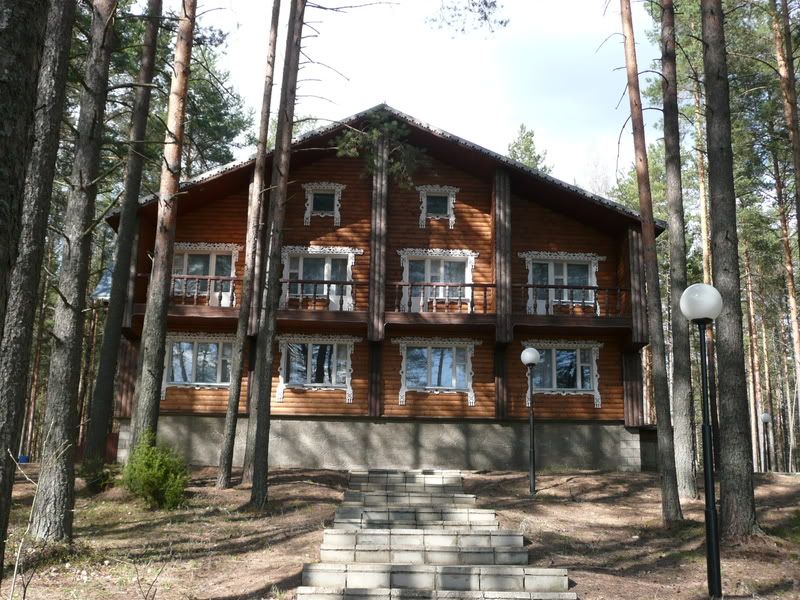 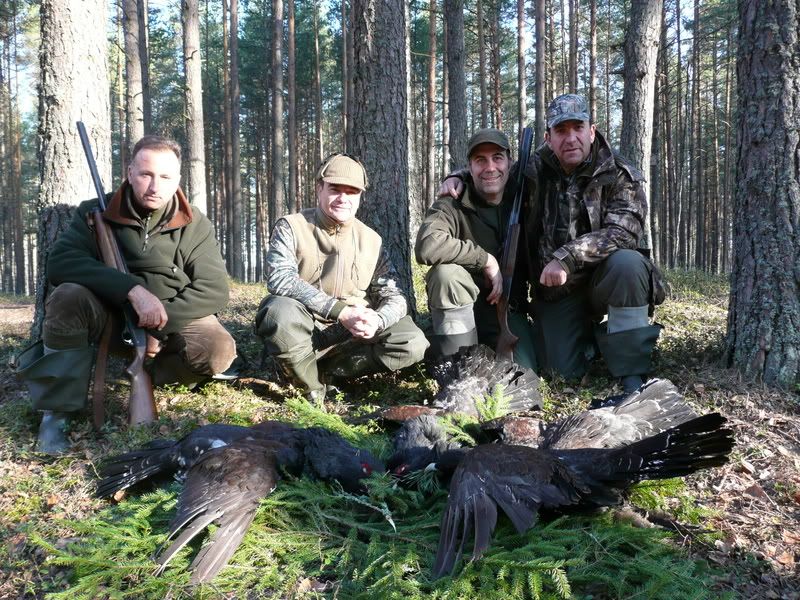 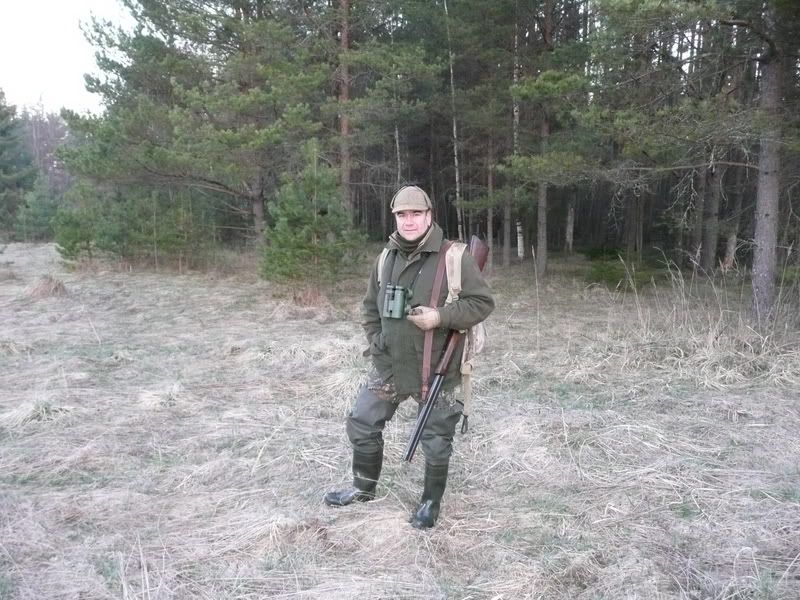 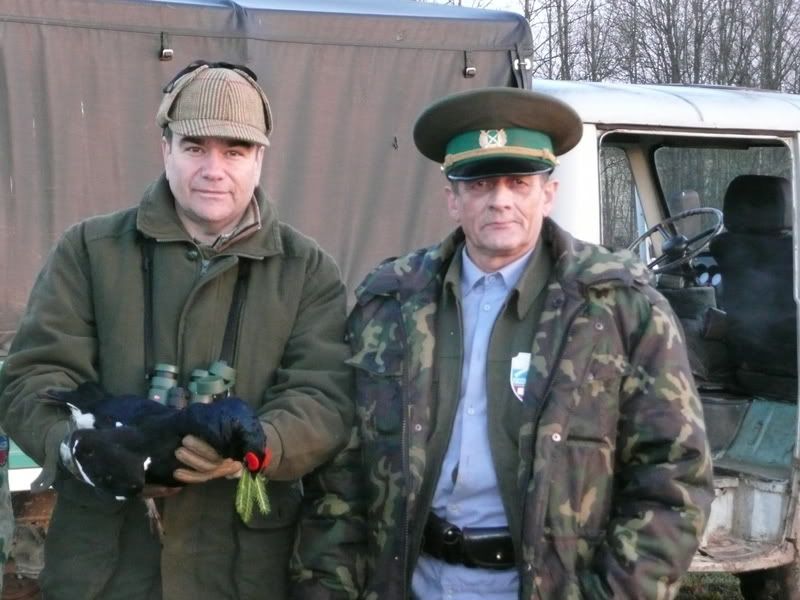  | |||
|
| one of us |
Nice birds, Montero. Weidmannsheil! - mike ********************* The rifle is a noble weapon... It entices its bearer into primeval forests, into mountains and deserts untenanted by man. - Horace Kephart | |||
|
| one of us |
Thanks for the photos...very interesting. Who is that on your left? _______________________________  | |||
|
| one of us |
YD, He is a Game Warden of the area, but he looks like the Minister of War of Stalin, doesn't he? Montero | |||
|
| one of us |
Yes, he looks like a relic from the cold war! _______________________________  | |||
|
| new member |
http://www.youtube.com/watch?v=B9Sh1QHbblo watch this movie from Finland. shows capercaillie hunting in wintertime. ...and some matingvideos, showing the males´fighting. http://www.youtube.com/watch?v=wf-rvfRviko&feature=related http://www.youtube.com/watch?v=HYvnowrrr-o&feature=related http://www.youtube.com/watch?v=JhmhveXxpq8&feature=related | |||
|
| One of Us |
I was told by the best bird taxidermist in the world Patrick Rummans that no one should shoot a Caper in the spring as they are molting. He said if you want one to look good mounted it needs to be shot in the late fall or early winter. So that leaves Russia and central Europe out of the equation. Do a google search for Pat's website and take a look at his work. | |||
|
| One of Us |
D99; Im not quite sure what you mean by "that leaves Russia and Europe out of the question.. Are you saying one cant hunt by that time, or what? If thats the case, I must say, youre wrong. I hunt them, successfully, from 25 of August til the end of January. That pretty much covers up "late fall and early winter". Sorry, I didnt see the word "central"... In this case it has a central part of the matter. | |||
|
| One of Us |
Asti, I was aware that they could be hunted in Scandanavia. As far as I know Russians and Austrians hunt them in the Spring when they are breeding. Then again Scanadnavia isn't central Europe. | |||
|
| One of Us |
No, I didnt read your post thorouhly til after I had posted... Sorry, but I had corrected myself, I must say to my defense! | |||
|
| one of us |
Seth, I'm not going to argue with you about the credentials of your preferred taxidermist. I will, however, respectfully suggest he may have got his knickers in a twist about capercaille. Taxidermists all over the World seem to be best at doing the animals they see a lot of, and that may not be capercaille for this guy. I would estimate that about 99% of all capercaille shot on trophy hunts are mounted. By far the most of those are hunted in spring. Believe me, a spring mount can be done with absolutely no untoward effects on the plumage. Does a capercaille loose feathers in the process of hunting?? Yes, that is quite common. The bullet/shot impact can have a negative effect, and they may loose feathers when they fall out of trees etc. That is one reason why it is a bit tricky to choose the right tool for hunting these birds. A Hornet is really the ideal caliber, unless you believe in using shot (a lot of Russian birds are hunted with shot). If your bird, like mine, sheds a bunch of feathers in the process of dropping dead from a 60ft treetop, make sure you pick up as many of those feathers as you can. When you need to transport the bird, steal a nylon stocking from your wife or girlfriend. Pack the bird in said stocking and freeze it. That is the best way to transport for minimal damage. A good taxidermist can normally repair plumage damage. My taxidermist (he mounts a LOT of these birds) keeps a stock of feathers for both capercaille and black cock, just in case. The mounts of the (spring hunted) birds he did for me have absolutely excellent plumage. Have you ever heard of a bird molting during its rut period?? Because I certainly have not! Plumage seems to play an important part in the ability of cocks to impress hens with their virtues. I can hardly imagine nature timing this all important period in a bird's life with its molting period! Besides, one of the important features of both capercaille and black cock is the vividly coloured area above their eyes (German: "Balzrosen"). This is most vividly coloured in the rut, and as it is an important element in mount, I would suggest a mount of a rutting bird is more spectacular than one taken in late autumn or winter. This webpage: http://www.jagd.it/hochwild/auerhahn.htm Has some excellent pictures of capercailles in the rut. Do they look like they are molting to you?? Seth, if you are looking for the best capercaille or black cock mount, I honestly think you have to look for advice elsewhere. - mike ********************* The rifle is a noble weapon... It entices its bearer into primeval forests, into mountains and deserts untenanted by man. - Horace Kephart | |||
|
| one of us |
Mike very well said - also - mind that rut is going on during April (sometimes even in March) here in CE - and the habitat is 800 m above sea level or higher - that means winter in the Alpine Nature's calendar - no shedding for sure. Let me just add a pic that shows a full color of that magnificient bird (in rut).  | |||
|
| one of us |
Beautiful. _______________________________  | |||
|
| one of us |
Sensational, isn't it! The colours are just out of this world! I have heard that the colours may vary from area to area. My taxidermist claims he can tell the difference between birds shot in Austria (or maybe the Alps?) and birds shot in Russia. Interestingly, I think you age these birds based on the number of feathers in their tails (German: "Stoos"). You are naturally looking for a mature, or even better: old bird. Somehow I also seem to recall the shape of the beak changes with age (???).... - mike ********************* The rifle is a noble weapon... It entices its bearer into primeval forests, into mountains and deserts untenanted by man. - Horace Kephart | |||
|
| one of us |
The red around the eyes reminds me of a pheasant (I'm looking at one right now)...some of the coloration too although the patterns are quite different. _______________________________  | |||
|
| one of us |
This is what the Germans call "Balzrosen" - translating directly to "rut roses". I think this is present in many (if not all?) of the cocks in the grouse family. Ptarmigan (snow grouse), black grouse, capercaille, hazel grouse all have it.... What is the name of the grouse shot in the Scottish Highlands at outrageous cost?? I think it has it as well... (Or is that a black grouse??) As I mentioned in my previous mail, this area seems to play an important part in the rut - swelling up and becoming more visible. Another attribute that I believe most grouse share are the "feathers" on their feet. I say "feathers" because I'm not actually sure they are feathers. But the feet of these birds are commonly covered with what the Germans call "Balzstiften" - perhaps a feature to allow them to cope better with snow. - mike ********************* The rifle is a noble weapon... It entices its bearer into primeval forests, into mountains and deserts untenanted by man. - Horace Kephart | |||
|
| One of Us |
http://www.birdtaxidermy.com/ He's good enough the entertainment industry has him building fake eagles, and such for movie adverts.   Sorry the photos aren't very big, I just copied them from his website. He also has some of the most fantastic Sage Grouse I have ever seen. I would love to have mounts of all the grouse of the world in my house. | |||
|
| One of Us |
I don't know how many Caper Pat does a year. Your right no matter how many he doesn't he's not going to be doing as many as one of your native guys. He has one several best in the world bird taxidermy contest. Ergo..... Well that's just an opionon. I am sure your guys mount more birds, they have to, not every American is over there whacking a horse of the forest every week. Neat mounts aren't they? Beautiful birds, I had heard they tried to introduce them in Alaska but they didn't take. Something was missing they needed. I would love to captive breed them. | |||
|
| one of us |
Seth, my main concern was to allow you to keep the option open of hunting for capercaille in the spring/rut. IMHO, it would be a pity if you (for whatever reasons) thought this was not the hunt for you. I know you like to sample different hunting experiences, and have quite a collection of European game. A capercaille and black grouse would be excellenbt additions to your collection - without breaking the bank. - mike ********************* The rifle is a noble weapon... It entices its bearer into primeval forests, into mountains and deserts untenanted by man. - Horace Kephart | |||
|
| One of Us |
Your right about that. I would like to hunt them both ways, with dogs in Scandavia and during the rut in Russia. Depending on how 2009 goes for me, and how many military engagements I have it is something I want to do. They are cheaper than your other premier Swiss trophy the Ibex! | |||
|
| One of Us |
This has been the quary of my dreams since 1957, when, as a child, I was given a 1957 edition of Shooters Bible by my father. I also became addicted to drillings because of that darned book. I've had many drillings and various other combination guns, but the Great Grouse is still just a dream. | |||
|
| Powered by Social Strata |
| Please Wait. Your request is being processed... |
|

Visit our on-line store for AR Memorabilia

